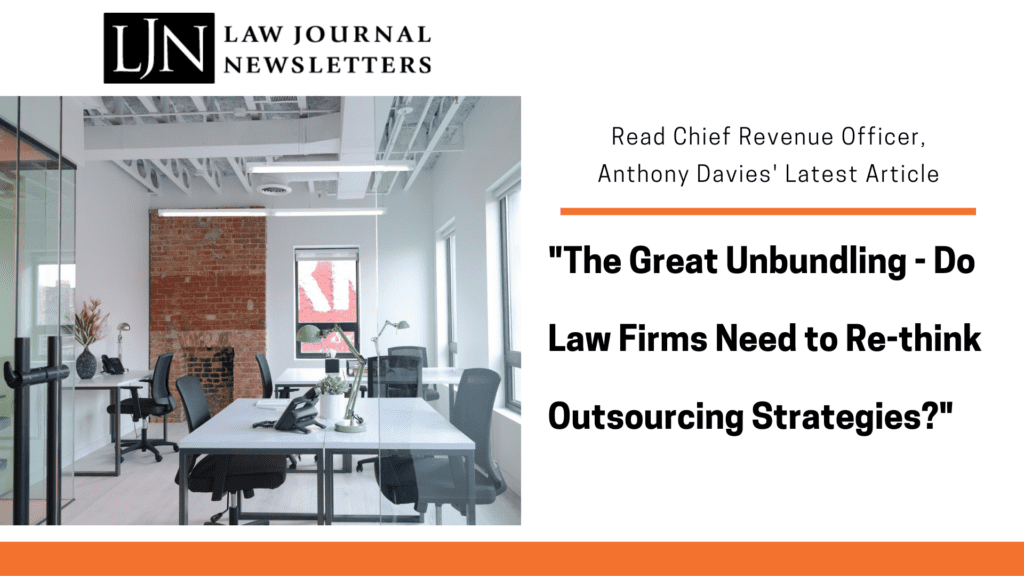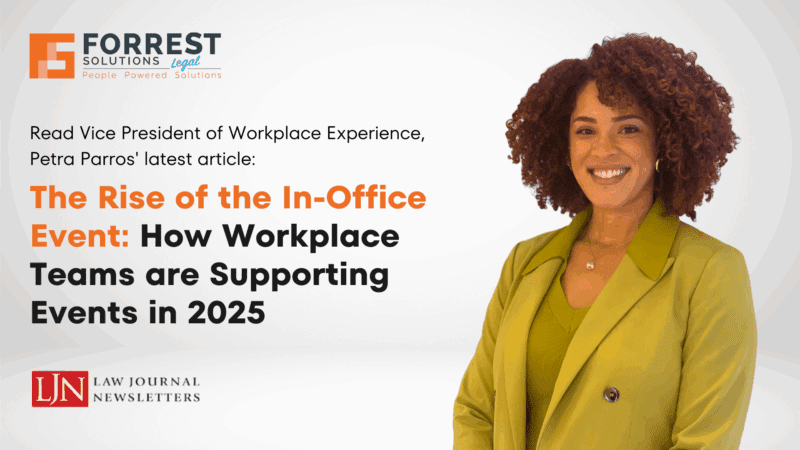
The Great Unbundling: Do Law Firms Need to Re-think Outsourcing Strategies?
By Anthony Davies
This article originally appeared in Law Journal Newsletters here
Outsourcing is on the rise. According to Deloitte[1], there’s an increasing shift to leverage outsourcing driven by learnings from COVID-19 which is to the capture the value which outsourcing models bring: increasing efficiency, reducing costs, and driving greater business value.
But service models are always evolving. For years, outsourcing providers have grown relationships with law firms by constantly adding new services to their core contracts and bundling them together as one package deal. Providers take these bundled services, then figure out the best delivery models–onsite, near-shore, or off-shore.
Service ‘bundling’ provides economies of scale, lower overheads, a single point of contact and a single invoice at the end of each month. However, the bundling of services to create a single multi-service provider may now be hurting firms who are increasingly looking for specialization, especially with regards to onsite Workplace Experience services.
Again, according to the Deloitte study, however, flexible sourcing models, with interchangeable or multiple service providers, is now becoming the mainstay for most client sourcing strategies. This outsourcing trend has been consistent over the past two years, with clients describing their strategies as “multi-vendor” and “multi-sourced.”[2]
How Does This Look in a Law Firm?
In the beginning (30+ years ago), outsourcing at law firms started with low value non-core services such as facilities, security, and switchboard. Quickly, other onsite services such as the reception, mailroom, print and copy center, records management, and administrative support services also were outsourced. Today, Litigation Support, IT, Finance, Marketing, and HR all have access to mature outsourcing offerings. In fact, the market estimate for global legal process outsourcing is estimated to rise by over 30% per year from now until 2027.[3]
Over time, outsourcing providers have added on-shore and off-shore Business Processing Outsourcing (BPO) centers to leverage global wage arbitrage and specialist skills. They have developed technology to assist with information and document workflow, launched alternative legal service offerings, and continue to work their way into increasingly complex areas of the law firm operations.
During the pandemic, these off site BPO centers grew exponentially as law firms grasped the opportunity to leverage the ‘remote work era’, and shift more administrative tasks to low cost, high quality off-site service centers. At the same time, the core onsite services were paired back as there was a reduced need for onsite support when everybody was working from home.
While cost savings and the uncertainty that still lies with COVID-19 are both major contributing factors for the rise in outsourcing, the ability to provide new, more sophisticated services cannot be understated. Law firms are able to receive customized industry solutions that allow them to capitalize on a changing landscape as more people move back to the office.
Outsourcing and Law Firms’ Return to Office: Introducing Workplace Experience
Fast forward to summer 2022, and core onsite services are taking center stage again as we slowly bring employees back to the office and ramp up in person support. However, the traditional outsourcing providers servicing the largest law firms have moved so far up the value chain, it is difficult to see them reinvesting and reinvigorating their low margin, lower value onsite offerings.
The need to bring employees back to the office is sparked by productivity concerns, needs to develop office culture, and lack of support for new onboarded staff. Many law firm leaders will argue that working in-person at some level is crucial to sustaining collaboration, innovation, mentoring and training. However, Thomson Reuters’ reports that the vast majority (83%) of attorneys now prefer some kind of hybrid work arrangement–and this increased desire is a key driver of the record breaking turnover rate (23.2%) reached at the end of 2021.[4]
We see the hybrid trends firms are forming. Cushman & Wakefield’s 2021 Bright Insights[5] report suggests 75% of firms are considering a hot desking program. However, as law firms begin to execute their return to office plans, they are quickly finding that their largest competitor in attracting attorneys back into their hallowed halls and also of course retaining talent is work-from-home. It is difficult to compete with the amenities that work-from-home offers—private refrigerator, cushioned couches, onsite laundry.
This is where workplace experience comes in. Workplace experience is a hospitality-based, high engagement, white glove service that transforms your office into an experience that is better than home. It is like the Ritz Carlton has come to transform the law firm office into a delightful experience—a very particular workplace experience, that is, that is a highly specialized outsourced service that can only be provided onsite (just like the Ritz Carlton).
With Law Firms moving dangerously close to losing a quarter of their attorneys, it is clear that there is a dramatic divide between what attorneys and staff are requiring from the law firm versus what they are actually receiving. Many firms understand the significant toll that the pandemic has placed on attorneys and staff. As partners have moved forward creating return-to-office plans, many have tried to reimagine the office with social and recreational activities, but only to ease the transition from remote. Creating a workplace experience requires the law office to reimagine the workplace in perpetuity.
Workplace Experience and the Multi-Sourced Approach
Service models are always evolving. Clients are increasingly seeking providers who can elevate the way they do business, enable them to be more flexible, and help them leverage the latest services, technologies and workflows. Understanding providers’ strengths is critical to deploying the right mix of large and niche providers to achieve the desired outcomes—but what is clear is that most organizations are moving toward a multi-sourced approach when it comes to outsourcing, and rightly so.
In a recent article published in Law.com, I highlighted the ‘Rise in Hospitality’ in other professional services, and some of the services banking clients are employing to attract employees back—and argued that law firms can learn from this model. For the skeptic may wonder, is this such a specialized service that it should be unbundled from, say, your document processing provider?
In a word, yes. Just like the experience of the Ritz Carlton is vastly different than the experience of a Super 8 Motel, the purpose and model of each are different because they serve different purposes. The purpose of workplace experience is to attract and retain law firm talent onsite, the number one challenge and risk faced by firms since 2020.
It can’t be accomplished with compensation alone. As compensation hits record levels—it hasn’t curbed turnover. Rather, employment choice is being driven by the experience they have while in the office. By adding a layer of 5-star hospitality services and creating concierge roles staffed with people who have experience working in 5-star hotels like the Ritz Carlton or Mandarin Oriental, the law firm office can become better than working from home. It can become a destination that attracts professionals back into the office voluntarily, sustaining vital collaboration, innovation, mentoring and training while eliminating the risk mandates bring of losing attorneys. That’s branding, that’s culture, that’s loyalty—outsourced.
[1] Deloitte 2021 Shared Services and Outsourcing Report
[2] Ibid
[3] https://www.researchandmarkets.com/reports/5530592/legal-process-outsourcing-market-global-industry?utm_source=BW&utm_medium=PressRelease&utm_code=qbzjrf&utm_campaign=1700834+-+Global+Legal+Process+Outsourcing+Market+Report+(2022+to+2027)+-+Industry+Trends%2c+Share%2c+Size%2c+Growth%2c+Opportunity+and+Forecasts&utm_exec=jamu273prd
[4] 2022 Report on the State of the Legal Market: Despite a strong year, numerous & growing challenges confront law firms – Thomson Reuters Institute
[5] https://www.cushmanwakefield.com/en/united-states/insights/bright-insight





